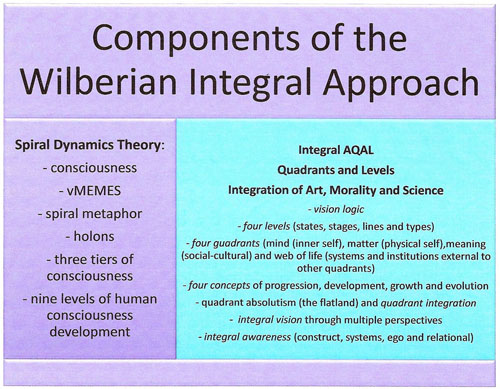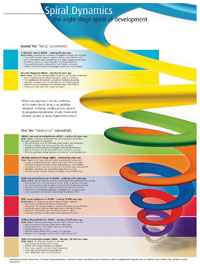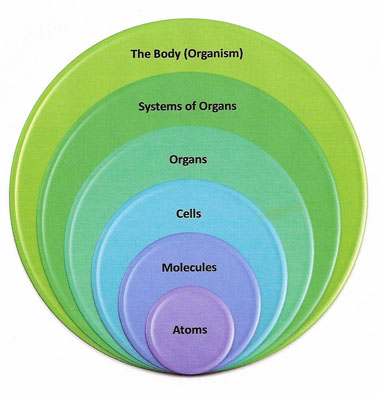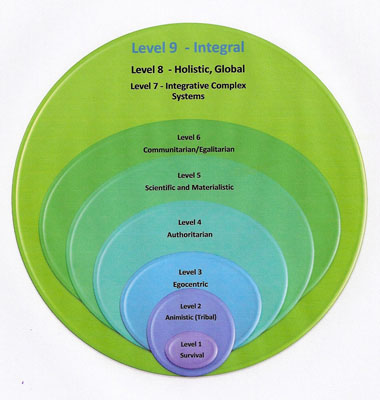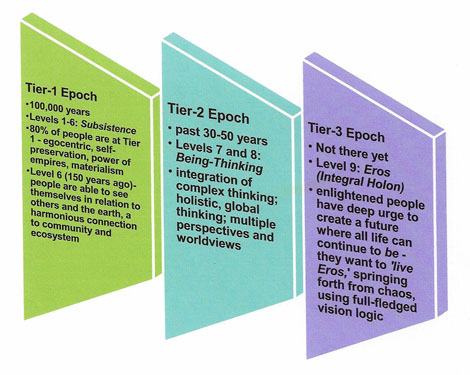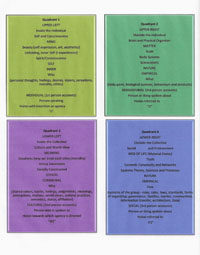Public Policy InvolvementVol. 20, No. 1
|
Interested in submitting an article to KON FORUM? Papers are now being accepted for review. |
|
Kappa Omicron Nu
|
||||||||||||||||||||||||||||||||||||||||||||||||||||||||||||
Level, Color and Prevalence in the world |
L ife Conditions, Value Premises (vMEMES) and Mental Coping Capacities and Complexity |
Where seen today |
Tier One - Subsistence Levels |
||
| Level 1 Beige: Instinctive Emerged 100,000 years ago .1% of today’s population |
live for survival, using basic biological instincts; fight-or-flight reflex; preservation of life and reproduction; ‘stay alive’ imperative | loose bands of people; people in famines |
Level 2 |
live for the past: the vulnerability experienced at the previous level leads people to associate in groups to mitigate survival mode and ensure certainty; allegiance to elders and kin; honour and placate mysterious ancestors and spirits (unseen powers) and animals through rituals, rites of passage and seasonal cycles |
Tribal peoples; clans; Aboriginal peoples; gangs; group rituals |
Level 3
|
live for now: the traditions built up in the previous level become frustrating, leading to exploitive psychological (fear) and physical power over people to maintain privileged positions; resources are concentrated with the elite (haves and have nots); survival of the fittest; ‘might-makes-right’ mind set; empires are built by exploitive leaders; respect and reputation matter more than life itself; enjoy self right now with no guilt; “it’s a jungle” |
slavery; exploitation of unskilled labour; street gangs; war lords; soldiers of fortune; bullies |
Level 4
|
live for the future: the fear from the previous level moves people to band together to overthrow dictators, leading to absolute belief in ‘the right way’; righteous living now guarantees future rewards; people conform to group norms to achieve security; serve the greater good through sacrifice; herd mentality; everyone in their place; laws, rules and regulations build discipline |
Puritan America; Salvation Army; religious fundamentalism; patriotism; totalitarianism |
Level 5
|
live for gains and pleasure: the stagnation and sacrifice from the previous stage leads to a value of growth, acquisition and materialism; strive for individual and scientific achievement, development and progress; self-interest is paramount; entrepreneurial spirit, innovations and economic motivations; Earth is there for the taking; laws of science rule everything; competition mind set; live the good life |
Wall Street; trans-national corporations; rampant consumerism; top-down globalization; colonialism |
Level 6
|
live for causes: the emptiness from the previous dogmatic stage creates a need for bonding with other humans and respecting a concern for the well-being of other humans (spiritual attitude rather than religious, per se); empowerment and liberation of previously oppressed voices; diversity of views and priorities; value community, equality, the environment, openness and trust; strive for harmony and solidarity; love and happiness through affiliations and sharing |
political and cultural dissenters; cultural creatives; Green Peace; Doctors without Borders; peace and human rights movements; political correctness; deep ecology |
Tier Two - Existential Being Levels |
||
Level 7
|
live for synergy: the fragmentation of the previous level leads to self-actualization and integration; flexible adaptation to change through connected, big-picture views; gain capacity to take multiple perspectives on life; pluralism; systems thinking; yellow thinkers work on the periphery, quietly fine-tuning systems behind the scenes; cooperation for the common good; able to deal with uncertainties and paradoxes; always questioning; flexible and spontaneous; chaos and change are natural |
Stephen Hawking; chaos theory; quantum physics; Margaret Wheatley; living systems; biomimicry; Carl Sagan; Peter Senge; Deepak Chopra; transformative learning |
Level 8
|
live for wisdom: isolated, self-actualized individuals in the previous stage seek each other out; like-minded people promote the idea of integral thinking; see themselves in balance with an integrated planet, as interlocking life forces (ecological alignment); emerging focus on spiritual connectivity; conscious of energy fields and merit of using collective human intelligence to work on large-scale world problems; attention given to whole-Earth dynamics and macro-level actions; coordinate actions globally; value wonder, awe and the unknowable; collective consciousness |
transdisciplinary inquiry, integral leadership, Gaia hypothesis, Ken Wilber’s work, Spiral Dynamics; David Bohm (holographs); McLuhan’s global village; Gandhi; noospheres |
Tier Three - Integral, Holon Level |
||
Level 9 |
live for others: the contentment gained from the previous stage opens the way to an otherworldly and transcendent life; enlightened people from the previous level assist other humans in developing their vision logic; if Tier-2 thinking is personal, Tier-3 is transpersonal; are able to live Eros (the urge to create the future supercedes the urge to liberate oneself or to transcend the world) |
any pioneer of Tier-2 thinking; Buddhists’ bodhisattva; those who focus on the Kosmos (especially Ken Wilber’s work) |
Other levels of human consciousness will follow as long as human nature and the complexities of human existence evolve. |
||
Tier-1 consciousness. Very succinctly, Tier-1 thinking (evolving over the past 100,000 years) comprises six subsistence levels (Levels 1-6, see Table 1 and Figure 2). Tier-1 thinking constitutes three distinct groupings: (a) egocentric (1st person, me perspective), (b) ethnocentric (2nd person, us perspective), and (c) worldcentric (3rd person, all of us perspective). Wilber (2007) proposed a 4th person perspective applicable when people are capable of holding all other three perspectives in their mind: 1st, 2nd, and 3rd persons (Cohen & Wilber, 2007). Almost 80 percent of the world’s population is operating at Levels 1-5 of Tier-1 subsistence thinking: egocentrism; self-preservation and survival; power of empires (conqueror, exploitation, manipulation); materialism; authoritarianism; and, personal autonomy and individualism (Wilber, 2010, and see also Korten, 2007).
The basic end value premises of Tier-1 thinking (Levels 1 to 6) are respectively, by Level: (a) reactive to survive (achieved through no value system); (b) safe, continued existence (via acceptance of tradition); (c) self-preservation and power (via exploitation); (d) salvation and tensionless state (via sacrifice); (e) materialism (via rational, objective positivism); and, (f) community with valued others (via consent-based decision making—sociocracy).
Tier-2 consciousness. Graves (1970, 1974) held that, with a huge revolutionary, quantum shift in consciousness (paradigm shift), people can move from subsistence living to Tier-2, being-thinking (Levels 7 and 8, see Table 1 and Figure 2). Tier-2 thinking has evolved only over the past 50 years. It is focused upon integration of complex systems and of holistic, global thinking. People at this level view themselves in balance with an integrated planet, as interlocking life forces. They are the people promoting the idea of integral thinking (Wilber, 2001).
Tier-2 thinking involves both an existence ethic (via acceptance of contextual rightness of actions) and a respect for the unknown, for the deeper things in life that are there to be experienced with a sense of awe, wonder, and mystery (Graves, 1970). People that have moved to Tier-2 thinking use trans-anything to convey moving beyond something: transpersonal, transmental, transcending, and transdisciplinary. People at Tier-2 use virtually the entire collection of levels of consciousness as they strive to weave together multiple levels of interaction and multiple perspectives (the entire spiral, minus Level 9) (Wilber, 2001, 2007) (see Figure 4.) Family and consumer scientists are familiar with their work: Margaret Wheatley, Stephen Hawking, Carl Sagan, Peter Senge, Deepak Chopra, and the transformative learning and leadership movement.
Tier-3 consciousness. No one is at Tier-3 thinking yet (Level 9), which involves being able to live Eros (Cohen & Wilber, 2007; Wilber, 2007, 2010). This approach to life entails an uncontainable urge to create the future from a position of personal enlightenment and transcendence (Phipps, 2007). People do so by integrating all nine levels of human consciousness, spiraling upwards through each level until all levels are mentally integrated. This represents very complex human thinking—holonic transmental.
Tier-3 thinking (Level 9) involves people, who have been enlightened from the previous levels, in assisting other humans in developing a full-fledged vision logic (to be discussed shortly). They follow a deep urge to create the future; this need supersedes the urge to liberate themselves, referred to as Eros. Their objective is to restore the world so that all life can continue to be. Murray (2009) and Wilber (2010) claimed no one has reached Tier-3, with the closest examples being the Buddhists’ bodhisattva and those who focus upon the Kosmos (different from cosmos). In an interview, Wilber explained that although cosmos refers to the physical universe, Kosmos (an old Pythagorean term) refers to the entire universe in all it its many dimensions (emotional, mental, spiritual, and physical) (Kornman, 1996). Wilber claimed that about 25 percent of the world’s population exhibits a readiness to develop Tier-3 integral thinking, especially teachers (Murray, 2009). Ray and Anderson (2000) labeled the people poised on this transitional cusp as Cultural Creatives. Wilber referred to this small but important pocket of people as members of an integral age at the leading edge.
Some examples serve to clarify the discussion. Wilber (2010) explained that Tier-1 thinking includes the pre-modern (traditional), modern, and postmodern eras (see McGregor, 2006). He referred to these eras as “general patterns of human consciousness and cultures” (see Table 1). Phipps (2007) provided useful, modern-day examples of these three Tier-1 eras in American society. He explained that the section of the populace that is religiously oriented and holds more conservative values are often called traditionalists. The more secular-oriented section, which values individualism, science, reason, pragmatism, and achievement, are the part of American society informed by modernity. The more progressive part of the populace, which values liberal politics, environmental awareness, social change, and new forms of spirituality, was recently labeled Cultural Creatives and comprises postmodern consciousness. Tiers 2 and 3 encompass the integral eras—epochs that are in their infancy (see Figure 5). Wilber’s research (2010) suggested that approximately 25 percent of the population is pre-modern (traditional), 40 percent is modern, 20 percent is postmodern (Levels 1-6) and only 2 percent is integral (Levels 7-9) (does not total 100 percent in the original source). Graves (1974) believed that other levels of human consciousness would follow as long as human nature and the complexities of human existence evolve.
Four Basic DrivesWilber (1995, 1999) used the concept of four basic drives to explain the process of clinging to one particular level, state, stage, line, or type (see Part Three) or letting go and evolving upward. He referred to this process as life and death (not physically dying but whether or not people spiral upward to a higher consciousness with a new set of values and a new world view). People have to let go of where they are now (die) in order to move upward (live). He employed the term translative to refer to movement within a given state (called horizontal life or death). He used the term transformative to refer to movement from one level to another (called vertical life or death) (Wilber, 1995).
Simply put, vertical life is a search for higher and wider unity and integration (higher levels of human consciousness). Vertical death refers to falling back down the holarchy, a form of contraction or regression to a lower and shallow sense of unity. Horizontal life (paradoxically) refers to holding onto one’s present state, clinging to one’s comfort zone, and horizontal death means being able to let go and transform to a different level (either upward or downward). Wilber (1995) maintained that people have to accept death at all states, stages, lines, and types (see Part Three) in order to reach a higher life. Denial of death means denial of progression, development, growth, and evolution.
Since Wilber wrote Sex, Ecology and Spirituality (1995), he has changed the terms he uses to refer to these concepts. He still uses transformation to define movement between holonic levels (vertical life) and translation to refer to movement within levels (horizontal life). Vertical life still concerns the drive for evolution (higher) and horizontal life still references the drive for holonic wholeness. The four drives now have different labels. The drives pertaining to vertical life are called Agape and Eros and the two drives dealing with horizontal life are called communion and agency.
Regarding horizontal life and death, all people have a drive to be part of a larger whole (communion). They strive for self-adaption and to join with others. When they fail at this, they experience herd mentality or disassociation. Also, people have a drive to “be a whole” (agency) instead of being part of the whole. They strive for self-preservation, autonomy, self-responsibility, and self-esteem. If they fail at this, they experience alienation, rigidity, frustration, and aggressiveness (Rentschler, 2006). The same principle holds: in order for people to evolve (live), they have to accept the death of a current state (Wilber, 1999).
People are drawn to find fullness—to embrace, enfold, or “love” the lower levels and pull them higher (called Agape, a downward embrace). They are being pulled by an involuntary force from above. If they are thwarted in this by being disconnected from a wider wholeness (Eros), they experience a death instinct, an unconscious urge to die (Thanatos, the death of their present level). Conversely, people have a drive to experience freedom, to find cohesion and unity through higher, deeper, and wider wholeness (called Eros). They want to self-transcend. If they do not succeed at this, they experience Phobos: fear, regression, panic, contraction, and repression (Rentschler, 2006). The same principle holds: in order for people to evolve (live), they have to accept the death of a current state (Wilber, 1999).
Part Three
AQAL Integral Theory
The previous section detailed the Spiral Dynamics theory of levels of development of human consciousness. The Wilberian approach to integral theory4 also draws on another key feature of integral theory—the integration of art, morality, and science at a time when society tends to keep them apart. From its inception, home economics/FCS has called for the integration of science with art and morality (Brown, 1993) so as to mitigate excessive fragmentation, hyperspecialization, alienated and siloed disciplines, and ubiquitous dualism. The problems of the world are simply too complex to be handled by any one discipline. The solutions to these problems require the integration of knowledge from the sciences, the arts, the humanities, and the administrative sciences. In addition it will require the involvement of members of the public and private sectors and of civil society to generate integral knowledge that respects as many perspectives as are needed to deal with complex problems. Wilber’s contribution to this is AQAL - All Quadrant, All Levels (2001, 2007, 2010). Before elaborating on the AQAL theory, brief mention is made of dualism and nondualism, the reason an AQAL theory is required in the first place.
DualismThe fundamental premise of the Wilberian integral approach is excessive dualism. Dualism (Latin duo, for two) is a philosophical position asserting that two sorts of reality should not be able to communicate or act upon each other. In other words, one reality has nothing to do with the other; one is superior to the other, or more real—like body and mind (see Figure 6 for more examples). Realities may bump up against each other, but they work on different sides of the street (Wilber, 2001). Most dualisms reflect only the hierarchical or ethnocentric assumptions upon which they are based (e.g., white and black, men and women, savage and civilized, evil and good, dark and light) (Rohmann, 1999). Thus, people or the world should not suffer from dualism, because it leads to conflict, polarity, and exclusion; integralism and nondualism are preferred (see below). To that end, Wilbur developed the AQAL theory. He believed that social problems require strategies capable of integrating perspectives rather than ignoring or diminishing them due to dualism.
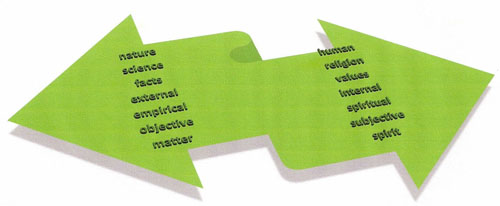
Figure 6 Examples of dualism
NondualismWilber favoured nondualism (meaning not two), understood to mean that different phenomena are inseparable or that there is no hard line between them, even though they are not the same. Nondualism assumes that reality viewed through dualisms is an illusion (i.e., false, not real, a deception); instead, nondual reality is the highest level of spiritual awareness, the highest level of the spectrum of human consciousness (Tier 3). Wilber placed it at the pinnacle of the holarchy of modes of consciousness. He maintained that for Tier 3 people, each moment of life is open and transparent—in readiness for being a Witness to all that arises out of their consciousness. This is how they progress, develop, grow, and evolve at Level 9. Also, Wilber defined eternal to mean ever present in the moment, not everlasting. Therefore, infinity does not mean enduring in time forever; rather, it means timelessness, a moment without time at all. For him (and many do not agree with this part of his theory, see Adams, 2002), infinite reality (nondual reality) is behind, beyond, above, below, and within, all at the same time (Wilber, 2007, 2010).
The concept of nondualism moves us into a discussion of the mystical, having a spiritual significance that transcends human understanding—one that inspires a sense of mystery, awe, and wonder, a deep connection with the Kosmos. The mystical dimension of the Wilberian integral approach is beyond the scope of this working paper. A very, very simple example of a peak experience might whet the appetite to read more about this aspect of his theory. Consider a person who has died and came back to life from an intense, outside-of-time, out-of-body experience. Imagine being enveloped in a warm, mellow, soft blankness, floating, at total peace, feeling connected to infinity—this happened to the author. Someone embracing dualism might interpret this as residual brain activity explained by science—one simply cannot be dead and alive at the same time. Someone embracing nondualism might interpret this as a mystical, spiritual experience, needing no scientific proof that it actually happened—life and death are not separate things; they are different yet can exist together for a person.
AQAL DefinedWilber (2001, 2007, 2010) developed an AQAL model (pronounced ah-qwul) to explain the complex integration of art, morality, and science. AQAL stands for All Quadrants, All Levels. Within the AQAL moniker, All-level refers to physical, emotional, mental, and spiritual levels or waves of existence--the Kosmos. All-quadrant refers to self (I), culture (WE), and nature (IT and ITS), respectively, art, morality, and science (Wilber 2001, 2007). AQAL is Wilber’s conceptualization of an integral map of human potential and possibilities, comprising five elements (states, stages, lines, types, and quadrants) and the concepts of progression, development, growth, and evolution (see Table 2). Figure 7 is a simple representation of the four quadrants, with more details to follow.
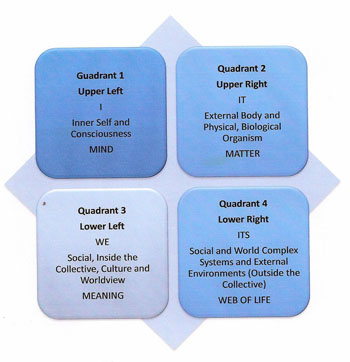
Figure 7 Four quadrants (simple representation)
In order to help home economics/FCS practitioners make intellectual connections using the Wilberian integral approach, it is necessary to explain each of the most elementary conceptual building blocks of the theory (see Figure 1 and Endnote #2): levels; aspects of integral movement (states, stages, lines, and types experienced through progression, development, growth, and evolution); four quadrants (mind, matter, meaning, and web of life); integral vision; vision logic; and four aspects of integral awareness.
LevelsFirst will be an overview of the AL component of AQAL—the All Levels (see Table 2 and Figure 8). A level is a general measure of higher and lower placement in a regular pattern of movement (up or down levels). Stage is a term used to emphasize the sequential unfolding of levels of development (see next section). Wilber (2007, p. 33) called moving from one level to another a “developmental jump.” Levels are not totally separate from each other; rather, they are fluid and overlapping waves (Rentschler, 2006). Wilber noted “that each stage represents a level depth of organization or a level of complexity” (pp. 32-33). He clarified that integral theory works with around 8-10 levels for any model of development. Levels of development are often represented using arrows, pyramids, concentric circles, or some other tool to symbolize movement, transcendence, and trajectory of expanding awareness. When Wilber referred to All Quadrants, All Levels, by the latter he meant “levels plus states, stages, lines and types” (All Levels), and he meant that all four quadrants contain all levels (each of states, stages, lines, and types). The follow section provides more information.
Integral Movement: States, Stages, Lines, and Types
Each person, and all of humanity, experiences progression, development, growth, and evolution (Wilber, 2001)—the four aspects of integral movement. His theory also includes states, stages, lines, and types (Figure 8). He weaved these together, with the following results (Table 2).
States are temporary moments and refer to potential for progression. States capture the reality that things are always shifting and changing. When people at one stage experience enough temporary peak experiences (“aha” moments), they have the potential to move to the next stage. Peak experiences are present one minute and gone the next. These peak states are the grease that helps people change stages, ensured through progression towards more advanced, more complete states. A toddler learning a new word is a peak experience. A person learning the English language experiences a permanent state.
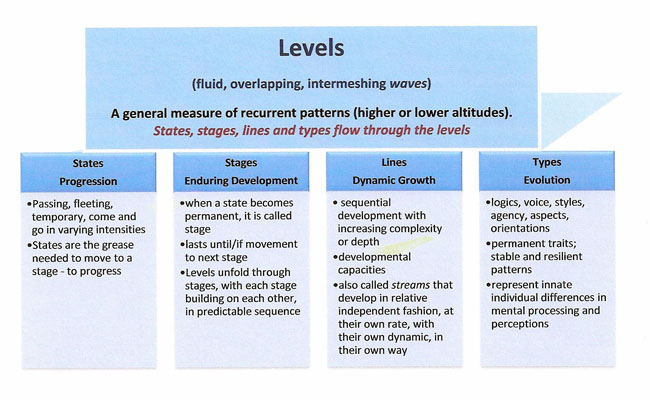
Figure 8 Levels, states, stages, lines and types
When a state becomes permanent, it is called a stage. Stages refer to permanent levels of existence. An identifiable series of stages unfold in a particular order and none can be skipped (development, to become more advanced). Unlike lines (see below), stages give way to the next stage. Each new development dependents on what came before and is a response to the limits of the previous stage. Each time people reach a new stage, they are said to have reached a milestone. Once people reach a stage, it becomes “an enduring acquisition” (Wilber, 2007, p. 31). Examples of stages include child development, stages of the family life cycle, and the life cycle of a fly.
Lines (streams) refer to dynamic growth. Lines demonstrate sequential development with increasing complexity or depth that transcends and includes previous levels (rather than giving way to previous levels). Lines develop in relative independent fashion of each other, at their own rate, with their own dynamic, in their own way. Wilber (2007) explained that people often lament, “I am good at some things, but not at others.” This sentiment reflects the unevenness of line development in most people—people are “more or less developed” than others around them (Esbjörn-Hargens, 2009). People simply are not equal in depth and complexity in all areas of their life. Within integral theory, the concept of lines reflects this reality. Examples of lines (increasing depth and complexity) include Maslow’s hierarchy of needs, Kegan’s orders of moral consciousness, Gebser’s worldviews, and Graves’ value vMEMES (Wilber, 2007). People move through levels of development, across numerous lines.
Types refer to evolution and are often represented as styles or typologies symbolizing permanent traits (e.g., blood types, body types) (Esbjörn-Hargens, 2009; Wilber, 2001, 2007). Typologies abound (e.g., Myers-Briggs personality types) and represent innate individual differences in mental processing and perceptions—how people see and relate to the world. Belonging to a type means that individuals share attitudes and dispositions, employ different logic (aspect or voice), and hold different orientations. Types are very stable, resilient, and enduring traits of human behaviour. Wilber (2007) and others asserted that the most prevalent type is the masculine and feminine voice or aspect (gender types). People often use the term sexual orientation. Individuals talk about kinship systems. Scholars refer to governmental regime types. Type dynamics directly and subtly affect people’s relationships with each other—hence, their development, progression, and growth.
Table 2 - Five elements of an integral approach (Wilber 2001, 2007) used with permission of McGregor, 2010a
Element |
Definition |
Example |
STATES
Progression |
temporary; come and go; passing; but, they build on each other. With enough peak experiences at a particular state, someone can progress to the next stage. Peak experiences are lubricant for moving from stage to stage. Experienced as ‘a-ha’ moments, glimpses into higher possibilities. In order for an altered state to become permanent, it must enter the stream of development. |
The powerful, moving, fleeting experience of listening to a moving piece of music played by a concert-level pianist - a peak state |
STAGES (levels of existence)
Development |
permanent; when a state becomes permanent, it is called a stage. However, stages take a considerable amount of time to develop. Stages unfold sequentially and cannot be skipped. The more frequently the temporary peak states occur, the faster the stages evolve. People cannot skip stages but they can accelerate their growth through them by gaining practice in temporary states. |
The concert-level pianist is at a stage, having moved from novice to concert level. |
LINES (streams)
Growth |
lines unfold through the stages. They are dynamic and indicative of growth. The level of the line is called its altitude (low, high and advanced). Lines can be straight, wavy or spiral (streams and waves) |
The concert-level pianist has advanced musical skills. |
TYPES (style, voice, logic, orientation)
Evolution |
permanent traits in one’s personal character (personality types). Typologies abound (e.g., Myers-Briggs) and represent innate individual differences in mental processing and perceptions - how people see and relate to the world. Belonging to a type means individuals share attitudes and dispositions, and employ different logic (aspect or voice). An individual can be a particular type at each state, stage, and line. A key example is male and female types/logics. |
The female concert-level pianist wishes to stir emotions of care, compassion and communing together (female logic). |
QUADRANTS (four parts divided by two lines at right angles)
Integration |
Wilber uses this element as the anchor for integrating the other four elements (stages, states, lines, types) which, when taken together, comprise the five elements of the AQAL theory of the Wilberian integral approach |
|
A quadrant perspective. From a truly integral perspective, Wilber (2001, 2007) posited that each quadrant has states, stages, lines, and types that correlate with other quadrants (see next section). Using lines as an example, consider a society’s cognitive development: “As the cognitive line develops in the UL [upper left] quadrant, there are corresponding behavioral and neuropsychological developments in the UR [upper right] quadrant, corresponding intersubjective capacities in the LL [lower left] quadrant, and grammatical structures in the LR [lower right] quadrant” (Esbjörn-Hargens, 2009, pp.10-11). As people learn to think and express themselves, their brains and psychomotor skills (hand-eye coordination) develop, as does their ability to learn what is considered appropriate within their social context, all the while grounding their learning within society’s system for grammar and communications. The next section discusses the concept of quadrants and provides a theoretical context for this concept.
Four QuadrantsAQAL theory proposes there are four quadrants, each of which includes progression, development, growth, and evolution (Wilber, 2007). This is the AQ part of AQAL (All Quadrants). Wilber used the quadrant as the organizational and integrative concept for his theory (see Figure 9). Quadrant is another word for dimension or perspective. The two left hand quadrants use “I” and “WE” language and the right hand quadrants use “IT” language. The latter comprise the singular, individual IT, and the plural ITS (collectives and systems). So, in effect, quadrants also are shorthand for first-, second- and third-person perspectives.
Quadrant 1 (upper left) represents the inside of individuals, their mind, consciousness, self-expression, and the essence of their inner self. Wilber called this the “I” quadrant. Quadrant 2 (upper right) represents the outside of individuals, both their brain and physical essence as understood by empirical science. He called this the “IT” quadrant (singular). Quadrant 3 (lower left) references life lived within the cultural collective, reflected in social norms, group awareness, morality, and life with others. He called this the “WE” quadrant. Finally, Quadrant 4 (lower right) represents life lived outside the collective in the web of life. This quadrant contains the collection of institutions, rules, and standards that shape and inform life. Wilber (2001) referred to this as the “ITS” quadrant (plural).
From an AQAL perspective, focusing on only one quadrant or dimension of an issue means that only one-quarter of the overall story is presented in the final analysis of the problem and resultant solutions. The upper left deals with the interior of people. The lower left concerns the importance of culture, the community context, and supportive networks. Both are referred to as the Left Domain, focused on the inner workings of humanity. The upper right deals with the physical organism (the human body and the brain) and the lower right concerns social, economic, political, and other systems, the macro context. Both are referred to as the Right Domain, with its concern on the outer aspects of humanity—the exterior. As well, the two upper quadrants deal with individuals, and the two lower quadrants deal with the collective (Wilber, 2001). All are needed to ensure a comprehensive, holistic appreciation of the nuances of the problematic situation.
Figure 9 - All quadrants in detail (Wilber 2001, 2007), used with permission from McGregor 2010a (click to view)
Quadrant Absolutism and Quadrant Integration
Finding the patterns that connect all of the elements in Tables 1 and 2 and Figures 2, 8, and 9 is a major accomplishment of the integral approach and the ultimate goal of anyone using this theory. Synergistic patterns are needed to solve the emergent, complex problems of the world, including uneven wealth and income distribution, injustices, uneven development, insecurity, conflict and aggression, and unsustainability. Every problem has four dimensions or perspectives (quadrants); thus, people need to draw on all quadrants to solve the problem (Wilber, 2001), as well as respect the integration of All Levels. As an example, the pervasive problem of mounting consumer debt contains dimensions of inner self (ethics and esteem) (UL), the consumer culture (LL), the global marketplace (LR), and the dynamics of consumer behaviour (UR). Within each of these quadrants are levels of development, including states, stages, lines, and types.
It is imperative that people learn to find the patterns that connect all of these elements instead of falling back on what is comfortable and standing in just one quadrant. Indeed, standing in one quadrant (e.g., the scientific, empirical upper right quadrant) results in an imbalanced, flat, one-dimensional approach to life, living, and leadership. The same can be said for standing alone in (a) the lower left morality, shared norms quadrant, (b) the upper left inner-self, artful self-expression quadrant, and (c) even the lower right web of life, complex systems, empirical quadrant. Leaving out any of these quadrants yields an incomplete picture of reality. Too much is missed, compromising one’s ability to deal with the complexity of life (see Figure 9). Wilber (2007) called this quadrant absolutism and urged people to strive instead for quadrant integration because no one of the four views of reality is more primary than the others—the y are all needed, together. Leaders using an integral approach are urged to avoid extreme scientism (outer matter is reality), extreme systems theory (the web-of-life is reality), extreme idealism (inner mind is reality) or extreme postmodernism (culturally constructed meaning is reality). Respectively, these represent science (nature, IT and ITS), art (self, I), and morality (culture, WE).
The spiral metaphor informs Wilber’s approach to integral theory. The spiral is undulating, unfolding, and continually evolving upwards and outwards—spirals are anything but flat. Wilber (2007) used the term flatland to describe what happens when one or more of the quadrants is ignored or undervalued, or too heavily favored, especially the upper right quadrant. This flatland ignores the common humanity shared by all global citizens. Without an integral perspective, people operate on a flatland; they fail to grasp the entire, full spectrum of human consciousness and moral development (see Figure 10).
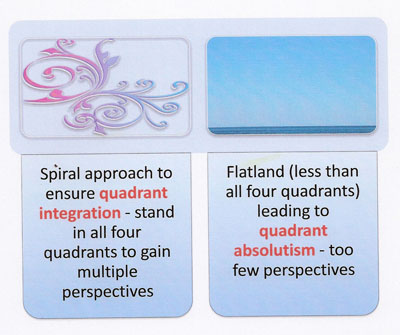
Figure 10 Quadrant integration versus flatland
An integral approach to practice moves the ideal of integrating art, morality, and science (the four quadrants) into concrete actions (Wilber, 2001, 2007). This integration entails bringing all four quadrants to each leadership situation, thereby ensuring a true representation of existing global complexities. People need science (IT and ITS), art (I), and morality (WE) to solve the complex, emergent problems of humanity (see Figure 9). This approach resonates deeply with the thinking of some of the founders attending the Lake Placid Conferences 100 years ago. In 1902 Alice Chown explained, “home economics in its broad sense is a subject for developing... the meaning of the physical, social, moral, esthetic [sic] and spiritual conditions of the home” (as cited in Brown, 1985, p. 263). As well, current practitioners are familiar with theorists working in each quadrant, making it more likely they might embrace the idea of considering the Wilberian integral approach. Freud, Jung, and Piaget represent Quadrant One. Skinner, Locke, and Watson contribute to Quadrant Two. Kuhn, Max Weber, Gebser, and Dilthey represent Quadrant Three, and Parsons, Comte, and Marx work within Quadrant Four (Wilber, 2001). Imagine if insights from all of these theorists were brought to bear on a problem; an integral vision would be much more probable.
Integral Vision Through Multiple Perspectives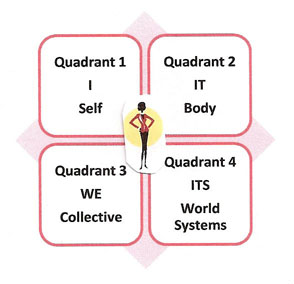
Figure 11 Standing in all four quadrants - everything has meaning
An integral approach or vision assumes people will try to respect and to learn from many, many perspectives. The intent is to be as comprehensive, inclusive, and caring as possible, striving for deep clarity of the situation. Wilber (2007) explained that people striving for an integral vision of the world will automatically scan all four quadrants, helping them to move their thinking towards a more integral and inclusive stance. Because they have integrated the five elements of AQAL (see Table 2), they are better able to make sense of everything (The Theory of Everything, Wilber, 2001). Standing in all four quadrants, everything now has meaning (see Figure 11). There is a place for everything. There is no right or wrong; rather, there is the question of how much complexity is needed to adequately understand a given situation from a holistic perspective, using the AQAL as a diagnostic and forward thinking tool. Wilber urged people to respect and to weave together learnings from (see again Figure 9):
- the interior and the exterior;
- the individual, the group, and the system;
- the body, mind (intellect), spirit, and shadow (repressed emotions);
- the arts, sciences, and morality;
- the ego (me), ethnos (us), and world (all of us);
- ourselves, others, and nature;
- beauty, goodness, and truth;
- group, nation, and global; and,
- the personal, the integrated, and the transpersonal.
Only through pluralism can integralism emerge (Wilber, 2001); yet, AQAL is more than mere pluralism (Wilber, 2006b). It is defined as holding one or more perspectives or positions at the same time. AQAL is the essence of synthesis and integration, a melding of perspectives to gain as much intellectual inclusion as possible. The result is a full-spectrum approach, because practitioners will have respected “the four most important dimensions of the Kosmos—namely, the interior and the exterior of the individual and the collective” (2001, p.42). Anything less means fundamental aspects of the integral whole are lost, and the ability to understand the issue and to address it is compromised (Esbjörn-Hargens, 2009).
Quadrivia. Although not mentioned often in discussions of an integral vision, Wilber (2006a) also used another construct to balance quadrants—quadrivia, Latin for place where four roads meet. From a standard quadratic approach, picture an individual situated in the center of the quadrants (see Figure 1). Imagine arrows pointing outward depicting the various realities that this individual can perceive as a result of applying the AQAL approach. Quadrants represent the many ways people can experience their own reality, the multitude of perspectives. Quadrivia, on the other hand, represents the four different ways people can look at other realities to understand them. Quadrivium (singular) refers to viewing reality through one quadrant (Rentschler, 2006). Picture the four quadrants again with a centered entity—only this time others are standing outside the matrix, looking in, and studying the entity at the centre. A quadrivial analysis is achieved by looking through the four perspectives at one phenomenon, person, occasion, or issue. The example used by Esbjörn-Hargens (2009) was fish dying in a lake. Experts from all four quadrants analyze the death of the lake and the fish, honoring the complexity of the lake’s reality and that of its inhabitants and beneficiaries.
Vision LogicWilber (2001) devised a new methodological logic to accommodate this new notion of integral, one that respects emergent tensions and energy. He calls this vision logic. It exists beyond the conventional and familiar Aristotlean logics of (a) ethos (moral authority), (b) pathos (emotions), and (c) logos (rational logic) (Ramage & Bean, 1998). Vision logic is the ability to conceptualize, compare, and synthesize different perspectives and points of view, leading to transcendental knowledge, while all the time generating, even depending upon, creative tensions. With vision logic, an individual can simultaneously hold multiple, apparently contradictory, perspectives in his or her attention and, through synthesis and integration, can conceptualize networks of interactions among the various perspectives (Marquis, Holden & Warren, 2001). The tenets of vision logic resonate with Edgar Morin’s complex thinking, Robert Kegan’s fifth order of moral consciousness, and Jean Gebser’s integral consciousness (Ferrer, Romero & Albareda, 2005; Wilber, 2007). With vision logic, people are able to take dualisms and transform them into healthy differentiations (Wilber, 1995, 2000).
Table 1 references four degrees of vision logic. Wilber (2001) characterized Level 6 as the earliest stage of vision logic wherein people are able to differentiate formal systems into multiple contexts. Levels 7 and 8 are middle and late stage vision logic, respectively, wherein people can integrate the differentiations made at Level 6 to varying degrees, while introducing their own new differentiations that later levels will integrate. Level 9 is characterized as full-blown vision logic, the beginning of truly transpersonal levels of consciousness. With this degree of vision logic, a person experiences flashes of genius but not as an enduring trait or permanent realization. Members of the human race seldom ever experience this type of thinking; we have few geniuses in our midst. Those who do achieve this level of thinking are often called visionaries (Wilber, 2007). Rentschler (2006) explained that vision logic is the cognitive stage necessary to support integral consciousness. It is a bridge between mental and transmental.
Integral Self-AwarenessA final component of the Wilberian integral approach to be discussed in this working paper is integral awareness. KON believes deeply in strengthening leaders’ awareness (Mitstifer, 2006). From an integral, AQAL perspective, such leaders would appreciate the merit of integrating four kinds of integral awareness. Murray (2009) proposed each of the following: construct aware (concepts, language, and knowledge), systems aware, ego aware, and relational aware (see Figure 12). He described this as a model for integral consciousness (Tier-2) enabling people to enrich their cognitive, interpersonal, and intrapersonal capacities to problem solve using the Wilberian approach.
Construct awareness enables people to flexibly approach uncertainties, paradoxes, and ambiguities that are an inherent part of weaving perspectives together. It is important that individuals come to understand how their own mind works and to be able to perceive their inner thought patterns. Systems reasoning (awareness) helps people flexibly coordinate whole systems of new ideas that they have not previously synthesized. Ego awareness (social-emotional intelligence) entails self-knowledge, a key component of integral thinking. It includes an increased depth of being, as well as compassion, wisdom, and empathy, which when released open powerful potential for creativity and growth. Relational awareness involves the development of emotional resilience and wisdom to make choices for the good of the whole, doable because of an imbued sense of interdependencies in social interactions (Murray, 2009).
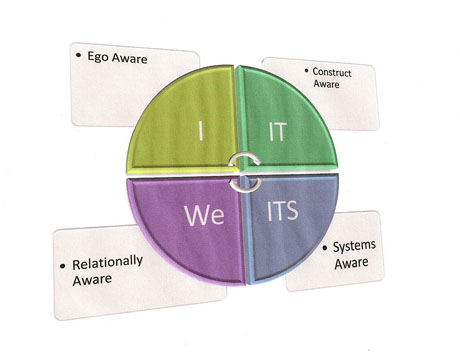
Figure 12 Integral awareness, used with permission from McGregor 2010a
Murray (2009) explained that these four types of awareness are significant to integral consciousness and that learning to integrate all four heightens one’s inner capacities and potential to move to higher holons. All four must be integrated to ensure a meta-perspective to integral practice. A meta-perspective allows people to understand how things fit into a larger scheme of things (McGregor, 2009b; Steech, 2007). Murray posited that higher levels of awareness point to not only more sophisticated inner capacities but to increased “depth of being” (“being in touch with deep sources of self-knowing, intuition, empathy, compassion, and presence that is associated with wisdom and transpersonal modes of awareness”) (p.115). Once people learn to release their cognitive and emotional attachments to specific worldviews or levels of consciousness development, they can settle into a state of open awareness and presence. This enables them to unleash their potential for synergy and growth (to stand in all four quadrants and evolve to the next holonic level). More open states of clarity obtained from richer integral awareness lead to higher wisdom, and they augment one’s potential to employ vision logic and the Wilberian integral approach.
Part Four
Wilberian Integral Approach In Practice
In summary, using the Spiral Dynamics and AQAL theories, people strive to have the five features arise in their consciousness (see Table 2). Temporary peak experiences that occur often and strong enough (states, progression) can result in permanent stages (development). At any given stage, people have the potential to grow, with this growth measured as low, high, and advanced developmental lines. The character traits, personality styles, and various logics (voices of agency) all shape the evolution of the person (types). An individual can be a particular type at any state, stage, or line. AQAL proposed that people would strive to realize this collection of progressions, developments, growth, and evolution in their selves, embody them in nature, and represent them in culture. Thus they integrate art, morality, and science to ensure an inclusive comprehension of their reality.
As this happens, people and civilizations spiral up through the levels of consciousness (see Figure 2), adapting to and creating new vMEMES, or they become stalled. Humanity always experiences various proportions of people living life at various levels of consciousness (holons) (see Table 1). This holonic movement is experienced through combinations of the four quadrants (dimensions or perspectives) and manifested in the never-ending upward quest of humanity. The objective is to achieve integrality, to find what is essential to ensure completeness and wholeness, and to avoid dualism, fragmentation, alienation, and exclusion. Individuals can employ various degrees of vision logic and do so from multiple layers of integral awareness. They will do so from a stance of quadrant integration (avoiding the flatland), always striving to spiral upwards. They will become “pacers of transformation, gently encouraging every activity within [their] reach to stand within a worldcentric . . . [holonic] atmosphere” (Wilber, 2001, p. 90). Readers can view a chart developed by Michael Dowd, which integrates Spiral Dynamics with AQAL, at http://www.thegreatstory.org/charts/spiral‑charts.html.
The Promise of the Wilberian Integral ApproachThe intent of this working paper was to provide an overview of the basic premises of the Wilberian integral approach, thereby creating a space for profession-wide conversations about the merit of this vanguard approach for our practice and our leadership. Home economists (FCS/human scientists) hold deep potential for becoming part of the .1 percent of the world’s integral leaders (estimated by Wilber, 2010). A Wilberian integral approach offers the promise for spiraling ever upward - complementing KON’s vision that being in today’s world demands a higher level of leadership than in the past and that this leadership path must be intentionally chosen (Mitstifer, 2006). There are other reasons for considering this approach to practice.
First, the concept of consciousness has a place in our practice. “Every problem in the world has its solution at least partially in the raising of consciousness” (Phipps, 2007, p. 3, emphasis added). Phipps elaborated that knowledge of a given society’s general level of human development is a powerful aid in analyzing the nuances and needs of that society, especially because the values shaping societies (vMEMES) are often informed by unconscious structures and dynamics (ideologies and paradigms) (McGregor et al., 2008). Integralism includes, among other things, “a sincere worldcentrism, a multicultural solidarity, an environmental priority, and a spiritual sophistication” (Phipps, p. 9). For these reasons, it makes sense for home economics/FCS practitioners to bring a consciousness-focused theoretical and philosophical lens to bear upon the world’s complex problems. The Wilberian integral approach could be that lens.
Second, a main assumption of the Wilberian integral approach is that as soon as people begin looking through the integral lens, everything has the potential to come into focus. Once that lens turns and clicks, people gain clarity and are able to make better decisions for the future (Phipps, 2007; Wilber, 2007, 2010). This improved decision making happens because an integral vision assumes people will try to touch all bases, try to respect and learn from many perspectives (stand in all four quadrants and strive for a never-ending upward spiral). The intent is to be as comprehensive, inclusive, and caring as possible, striving for deep clarity of the situation (Wilber, 2007). Rather than excluding points of view, people would strive to adopt all views that are useful for dealing with the current complexity of the dilemma and do so by looking for things they would otherwise ignore; they would employ an AQAL approach informed by all nine levels of human consciousness.
Third, the Wilberian integral approach draws together an already existing number of separate theories and paradigms into an interrelated network of approaches that are mutually enriching rather than in competition with each other or assumed to be separate and not related (Esbjörn-Hargens, 2009; McGregor, 2009a; Wilber, 2003). This approach means that FCS/human sciences practitioners are not expected to leave behind all that with which they are familiar (McGregor et al, 2008); rather, they would now pull each piece forward and examine it in light of the complexity at hand, seeking to respect tensions and new mergings. Upon deep examination, they would begin to weave together the insights that help address the complex human problem at hand, always clarifying the level, state, stage, line, type, and quadrant(s) from which they are problem solving (Wilber, 2007).
Fourth, using a Wilberian integral approach, home economists/FCS practitioners would attempt to include as many perspectives, theories, conceptual frameworks, taxonomies, and methodologies as possible (McGregor, 2009a). This approach would move the discipline and profession beyond the fragmented, specialized approach so harshly criticized by Brown (1993). It would also address the new science notions of connections, emergence, chaotic order, tensions, patterns, complexity thinking—holonic and holistic (McGregor, 2007, 2010d). From a Wilberian integral approach, practitioners would strive to evolve to higher levels of integration, appreciating that each level has the capacity to be more integrative than its predecessor. Once learned, this complex, holonic mode of thinking cannot be lost (like riding a bicycle). The former ways of knowing and being become integrated into the practitioner’s most current level of consciousness; the former ways of practicing are now in the background instead of being foremost in the person’s mind, creating a holonic, spiral, upward movement.
Fifth, to address the accelerating complexity of global reality, home economics/FCS practitioners would strive for Tier-3 Wilberian integral practice, strive to become part of that .1 percent of the world’s integral leaders (estimated by Wilber, 2010). Those who do achieve this level of thinking are often called visionaries, able to establish tensegrity (short for tension integrity). They would respect a semi-stable mix of order and chaos and accept that people are capable of self-stabilizing by redistributing and diluting stress upon systems. This form of thinking creates a new collective energy core thatMcGregor (2006) discussed as the holomovement principle. It resonates with the definition of integral as focused upon the emergent and healthy tensions that hold things together as they continually evolve—order in chaos, respecting uncertainty, disorder, emergence, risk, and insecurity (McGregor, 2010d). At this highest level of thinking, people are able to find a different kind of balance, one that is called the edge-of-chaos. The insights of enlightened sages who think this way are applicable to the whole world, not to just local situations (Cowan & Todorovic, 2004; Lucas, 2008). Professionals who practice on the edge of chaos have a powerful platform.
Sixth, adopting the Wilberian integral approach gets easier with practice. Wilber (2007) described the computer as a metaphor and proposed an Integral Operating System (IOS). He held that once people download the IOS (embrace the integral philosophy and the tenets of integral theory), their insides light up. A new sense of what is possible is activated; they are now experiencing more luminous clarity resulting from many carefully weighed perspectives, All Quadrants, All Levels. Home economists/FCS practitioners would appreciate that there is no right or wrong; rather, there is the question of how much complexity is needed to adequately understand a given situation from a holistic perspective. A Wilberian integral approach predisposes people to become more quadrant inclusive, leading to more self-awareness.
Wilber (2007) provided a set of modules to guide people’s practice to bring integrality into their daily lives. He referred to an Integral Life Practice Handbook, which is now available at http://www.MyILP.com He argued that, through daily practice in a variety of areas in life (i.e., body, mind, spirit, shadow (repressed emotions), ethics, work, relationships, sex, and emotions), individuals gain greater freedom and fullness in their lives, leading to more integration of perspectives and worldviews.
Integral Possibilities
Wilber posed the following questions and raised the following salient points that readily apply to home economics/FCS practitioners:
The question remains: exactly how will [a holonic and integral approach] be conceived, understood, embraced, and practiced? What precise details, what actual specifics, where, how, and when? We are waiting for [people] who will frame an integral system that will call us to our more encompassing future, that will act as a gentle pacer of transformation for the entire spiral of human development, honoring each and every wave as it unfolds, yet kindly inviting each and all to even greater depth. (Wilber, 2001, p. 90)
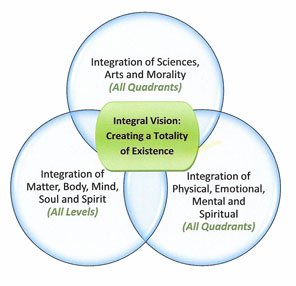
Figure 13 Creating Integral Vision to acknowledge the totality of our existence
How would home economists/FCS professionals go about conceiving, understanding, embracing, and practicing the Wilberian integral approach? What might this look like in practice? Bringing this theoretical orientation to home economics/FCS will have its challenges; it will not be easy. It asks home economists to view practice through integral vision. This would include the integration of (a) science, art, and morality; (b) self, body, collective, and world systems (All Quadrants); and, (c) matter, physical (body), emotional, mental, and spiritual (levels, states, stages, lines and types) (All Levels), creating a Living Totality (Wilber, 2001, 2007) (see Figure 13). The hallmark of an integral approach, the integral vision, is to make sense of everything, to find patterns that connect all manifestations, all matter, all life, all thought, and all experiences, so they can fit together into a coherent whole. If as many bases are covered as possible, people can be sure they are viewing a given situation from every conceivable angle (All Quadrants, All Levels), and can then proceed with the best information and deepest insights (Integral Life, 2010).
As an intellectual aside, the cornerstone of the Wilberian integral approach is its focus on human consciousness and the rejection of dualism (via the AQAL approach). In a book titled No Boundaries, Wilber (1979) provided a lucid discussion of absolutism and dualism and how they are linked to consciousness. He explained that Western thinking involves drawing boundaries around things to create separate entities. What is inside the boundary cannot be outside it; they are opposites. Western thought views opposites (dualisms) as apart, divorced, and totally separate; they are reconcilable. Opposites lead to conflict, because they cannot exist at the same time. To mitigate the conflict, people often spend their time dismissing one of the poles or trying to reduce it to the other, and no one wins.
Integral thinking favours non-dualism, wherein opposites may be different from each other but they cannot be separated from each other. His powerful example is buying and selling. They are different but they are also completely inseparable. One cannot buy something unless another is willing to sell it. They are two different events but are completely connected. They cannot be separated because integral thinking presumes there are no boundaries in the real world. Boundaries exist because humans feel a need for maps to traverse their daily terrain. These illusionary boundaries take the form of words, symbols, signs, thoughts, and ideas that demarcate life (Wilber, 1979). The results can be fragmentation and compartmentalization, leading to fear, alienation, and aggression, plus disconnectedness and disengagement from the energies of life.
He uses a simple example. A blank sheet of paper has no boundaries. Once someone draws a circle on the paper, a duality is established. Dualism assumes that what is in the circle cannot be outside the circle and vice versa. Conversely, integral thinking embraces non-boundary awareness. Liberation from the imagined conflict (the duality) comes from removing the boundary (or never putting it there in the first place) and accepting that things are different but not inseparable; rather, things are intricately bound up with each other—integrated together. He called this unity consciousness—being aware that all things are in unity, not separate (Wilber, 1979). Using this line of thought, Wilber (2001, 2007, 2010) aligned Spiral Dynamics theory (with its focus on human consciousness) with AQAL, with its focus on unity and integration.
This is the Ken Wilber theoretical position—he asks people to literally change how they understand reality, the state of things as they actually exist. He advocates an integral vision of reality, an ambitious vision that encompasses the totality of existence (see above), no boundaries. His ultimate ambition is to formulate a new integrated vision of reality that would incorporate the best of sciences, psychology, religion, philosophy, and other disciplines. This theoretical approach would be a timely innovation for the home economics discipline and profession that has fallen prey to hyperspecialization and dualism despite its rhetoric of interdisciplinarity, even transdisciplinarity (Brown, 1993; McGregor, 2010b).
This working paper was predicated on the assumption that the Wilberian integral approach is a viable theoretical orientation for the discipline, one that may be more readily received by its members than first anticipated. Indeed, home economists/FCS professionals are no strangers to integral thinking, although these two particular theories may be new to them (the Spiral Dynamics and AQAL theories). Several FCS philosophers, theorists, and curriculum developers have and continue to draw deeply upon recognized integral thinkers: Georg Hegel, Jürgen Habermas, Jean Piaget, Lawrence Kohlberg, Robert Kegan, and Abraham Maslow (Phipps, 2007; Wilber, 2001). Home economists/FCS practitioners are no strangers to systems, ecosystems, and human ecology theories—all predicated on integration and holistic thinking (Bubolz & Sontag, 1988; McGregor, 2010d). Furthermore, the American body of knowledge now acknowledges integration and holism as key components of practice (Nickols et al., 2009).
As noted, many home economists are familiar with the theorists who stand within the four quadrants of Wilber’s AQAL theory (2001, 2007, 2010) and are familiar with the multitude of theorists that inform the Spiral Dynamics theory (the many levels, states, stages, lines, and types—over 100 according to Wilber—from Eastern and Western thought, ancient and modern). Home economists/FCS practitioners already have a substantial predisposition to integral thinking and definitely to the concepts of integration and holism. They are familiar with transformative leadership and learning, and all were socialized into the profession through an interdisciplinary lens (the use of synergy to weave together multiple perspectives to address perennial, practical problems).
Those employing the Wilberian integral approach believe that everything happens in relationship to everything else and that respect must be given to emergent tensions in ever-changing relationships informed by transitioning vMEMES and all four quadrants. Integral practitioners must be open to modifying their own value constellations, their vMEMES, often changing their entire life purpose. Encouragingly, many home economists/FCS practitioners are familiar with reciprocal relationships, global thinking principles, futures thinking, and value clarification and values reasoning.
Beck and Cowan (1996) clarified additional traits of an integral informed practitioner, traits that have the potential to deeply resonate with home economists/FCS practitioners and their existing theoretical orientations. First, integral practitioners recognize that they need to understand the nature of holonic human consciousness development in order to understand the very nature of individual and humanity-wide change; human consciousness as a theoretical construct cannot be ignored.
Second, they recognize the significance of all levels of development in the evolution of human consciousness. Each holonic vMEME transition is a necessary part of human evolution; each vMEME represents prevailing worldviews that shape daily family life (see McGregor et al., 2008). All levels are necessary for the transformation and transcendence of humanity, of which families are the backbone institution.
Third, they realize it is not appropriate to endorse any one level or holon of development (or quadrant); all are necessary for progression, development, growth, and evolution. The more complex the problem, the more comprehensive must be the solution.
Fourth, integral informed practitioners refrain from forcing people to remain or move to any one level; instead, they facilitate transitions. They teach about paradigm shifts and invite people to grow and develop their human potentials to the best of their abilities, at their own pace (something that is commonplace in home economics/FCS practice for those who employ the system of three actions approach).
Fifth, as they do this, these practitioners remain cognizant of the four basic drives motivating people to move within and between levels and holons. People have to be willing to let go of one state in order to evolve to the next. Resistance to change and evolution is normal and needs to be scaffolded, including the use of an integral approach.
Finally, they acknowledge that the development of the human consciousness is a natural process through which all go on the never-ending upward quest—all individuals, organizations, disciplines, professions, cultures, and indeed all of humanity (Beck & Cowan, 1996).
A complex world requires a complex lens on the world in order to be as inclusive, comprehensive, embracing, and encompassing as possible; that is the promise of the Wilberian integral approach. Its use, however, may sound complicated and theoretically far removed from the real world of home economics/FCS. No doubt, the Wilberian integral approach is a very different stance than that of pervasive dualism and hyperspecialization that characterize many disciplines these days, including home economics/FCS. Yet, other disciplines that use the integral approach claim the results in consciousness development and changing mind-sets are simple and elegant (e.g., ecology, business, education, politics, economics, law, forestry, international development) (Esbjörn-Hargens, 2009).
Coming from frequent experiences of fragmentation, hyperspecialization, and dualism, some home economists/FCS practitioners may feel motivated to achieve wholeness. Indeed, many members of the profession are poised to be receptive to integral theory because of their natural tendency to integrate and strive for holism. The intent of this working paper was to create an intellectual space within the profession to engage with integral theory, especially the Wilberian integral approach. Murray (2009) estimated that the proportion of those ready to begin integral thinking is as high as 50 percent for teachers and university educators, and... most home economists/FCS practitioners are educators. By remaining open minded and receptive to adding new theories, approaches, and philosophies to their repertoire, home economists/FCS practitioners who are poised on the threshold of more complex, holonic, and integral thought can choose to augment their practice with Ken Wilber’s approach to integral theory. Welcome to the conversation.
References
Adams, G. (2002). A theistic perspective on Ken Wilber’s transpersonal psychology. Journal of Contemporary Religion, 17(2), 165-179.
Beck, D., & Cowan, C. (1995). Spiral Dynamics®. Cambridge, MA: Blackwell.
Brown, M. M. (1985). Philosophical studies of home economics in the United States: Our practical intellectual heritage (Volume I). East Lansing, MI: Michigan State University.
Brown, M. (1993). Philosophical studies of home economics in the United States: Basic ideas by which home economists understand themselves. East Lansing, MI: Michigan State University Press.
Bubolz, M., & Sontag, S. (1988). Integration in home economics and human ecology. Journal of Home Economics and Consumer Studies, 12(1), 1-14.
Cohen, A., & Wilber, K. (2007). The leading edge of the leading edge. EnlightenNext, 38(Oct-Dec), Retrieved from http://www.enlightennext.org/magazine/j38/guru-pandit.asp
Cowan, C., & Todorovic, N. (2004). Colors of thinking in Spiral Dynamics®. Santa Barbara, CA: NVC Consulting. Retrieved from http://www.spiraldynamics.org/Graves/colors.htm
Esbjörn-Hargens, S. (2009, March). An overview of integral theory. Integral Institute Resource Paper No. 1. Retrieved from http://integrallife.com/files/Integral_Theory_3‑2‑2009.pdf
Ferrer, J. (2004, May). Integral transformative practice: A participatory perspective. Retrieved from the Integral World Web site: http://www.integralworld.net/index.html?ferrer.html
Ferrer, J., Romero, M., & Albareda, R. (2005). Integral transformative education. Journal of Transformative Education, 3(4), 306-330.
Graves, C. W. (1970). Levels of existence. Journal of Humanistic Psychology, 10(2), 131-155.
Graves, C. W. (1974). Human nature prepares for a momentous leap. The Futurist (April), 72-87.
Gunnlaugson, O. (2008). Shedding light on the underlying forms of transformative learning theory. Journal of Transformative Education, 5(2), 134-151.
Hampson, G. P. (2010). Futures of integral futures. Futures, 42(2), 134-148.
Integral Life. (2010). Introducing the integral vision. Boulder, CO: Author. Retrieved from http://integrallife.com/node/47214
Integral Review Editors. (2007). Developing Integral Review: IR editors reflect on meta-theory, the concept of ‘integral,’ submission acceptance criteria, our mission, and more. Integral Review, 5, 278–291.
Kornman, R. (1996, September). The Kosmos according to Ken Wilber. Shambhala Sun, pp. 34-41, 64-66.
Korten, D. (2007). The great turning. San Francisco, CA: Berrett-Kohler.
Lucas, C. (2008). Essays in alternative dimensions: Spiral complexity dynamics. Vancouver, BC: The Complexity and Artificial Life Research Concept of Self-organizing Systems Organization [CALRESCo]. Retrieved from Http://www.calresco.org/wp/spiral.htm
Marquis, A., Holden, J. M., & Warren, E. S. (2001). An integral psychology response to Helminiak’s (2001) ‘Treating spiritual issues in secular psychotherapy.’ Counseling and Values, 45(3), 218-236.
Maslow, A. H. (1971). The farther reachers of human nature. New York: Harper.
McGregor, S. L.T. (2006). Transformative practice. East Lansing, MI: Kappa Omicron Nu.
McGregor, S. L.T. (2007). Consumerism, the common good and the human condition. Journal of Family and Consumer Sciences, 99(3), 15-22.
McGregor, S. L. T. (2009a). Integral metatheory: Beyond specializations, theoretical pluralism and conventional metatheory. Family and Consumer Sciences Research Journal, 38(2), 142-157.
McGregor, S. L. T. (2009b). Meta-review of IJCS home economics-related book reviews. International Journal of Consumer Studies, 33(4), 515-520.
McGregor, S. L. T. (2010a).Consumer moral leadership. The Netherlands: Sense Publishers.
McGregor, S. L. T. (2010b). Historical notions of transdisciplinarity in home economics. KON FORUM, 16(2) http://kon.org/archives/forum/16‑2/mcgregor.html
McGregor, S. L. T. (2010c). Home economics as an integrated, holistic system: Revisiting Bubolz and Sontag’s 1988 human ecology approach. International Journal of Consumer Studies DOI: 10.1111/j.1470-6431.2010.00920.x
McGregor, S. L. T. (2010c). Integral leadership and practice: Beyond holistic integration. Journal of Family and Consumer Sciences 102(1), 49-57.
McGregor, S. L. T., Pendergast, D., Seniuk, E., Eghan, F., & Engberg, L. (2008). Choosing our future: Ideologies matter in the home economics profession. International Journal of Home Economics, 1(1), 48-68.
Mitstifer, D. (2006). Leadership responsibilities of professionals. In S. L.T. McGregor, Transformative practice (pp. 133-162). East Lansing, MI: Kappa Omicron Nu.
Molz, M., & Gidley, J. (2008). A transversal dialogue on integral education and planetary consciousness. Integral Review, 4(1), 47-70. Retrieved from http://integral‑review.org/documents/Molz‑Gidley,%20Transveral%20Dialogue,%20Vol.4%20No.1.pdf
Murray, T. (2009). What is the integral in integral education? Integral Review, 5(1), 96-134. Retrieved from http://www.integral‑review.org/documents/Murray,%20Integral%20Pedagogy%20Vol.%205%20No.%201.pdf
Nickols, S., Ralston, P., Anderson, C., Browne, L., Schroeder, G., Thomas, S., & Wild, P. (2009). The family and consumer sciences body of knowledge and the cultural kaleidoscope. Family and Consumer Sciences Research Journal, 37(3), 266-283.
O’Sullivan, E. (1999). Transformative learning. NY: St. Martin’s Press.
Phipps, C. (2007). Integral politics comes of age. EnlightenNext, 38(Oct-Dec), Retrieved from http://www.enlightennext.org/magazine/j38/mcintosh.asp
Ramage, J., & Bean, J. (1998). Writing arguments (4th ed.). Needham Heights, MA: Allyn & Bacon.
Ray, P., & Anderson, S. R. (2000). Cultural creatives. NY: Harmony Books.
Rentschler, M. (2006). AQAL glossary. Journal of Integral Theory and Practice, 1(3), 1-39.
Roemischer, J. (2002). The never-ending upward quest. EnlightenNext, 22 (Fall/Winter), 105-126.
Rohmann, C. (1999). A world of ideas. NY: Ballantine.
Steech, E. L. (2007). A meta-perspective on leadership. Integral Leadership Review, 7(2), retrieved from http://www.integralleadershipreview.com/archives‑2007/2007‑03/2007‑03‑stech.php
Terry, R. W. (1993). Authentic leadership. San Francisco, CA: Jossey-Bass.
Wheatley, M. (1994). Leadership and the new science. San Francisco, CA: Berrett-Koehler.
Wilber, K. (1995). Sex, ecology and spirituality. Boston, MA: Shambhala.
Wilber, K. (1979). No boundaries. Boston, MA: Shambhala.
Wilber, K. (1999). The collected works of Ken Wilber, Volume Two. Boston, MA: Shambhala.
Wilber, K. (2000). Integral psychology. Boston, MA: Shambhala.
Wilber, K. (2001). The theory of everything. Boston, MA: Shambhala.
Wilber, K. (2003). Foreword. In F. Visser, Ken Wilber: Thought as passion. NY: SUNY Press.
Wilber, K. (2006a). Integral spirituality. Boston, MA: Shambhala.
Wilber, K. (2006b). Ken responds to recent critics. Retrieved from http://www.kenwilber.com/Writings/PDF/KenRespondstoRecentCritics_CRITICS_2006.pdf
Wilber, K. (2007). The integral vision: A very short introduction. Boston, MA: Shambhala.
Wilber, K. (2010). Kosmic karma and creativity: Volume 2 of Kosmos Trilogy [online excerpts from working draft]. Boston, MA: Shambhala. Retrieved from Http://wilber.shambhala.com/html/books/kosmos
^ 1. Readers are invited to peruse Wilber’s free online, e-learning primers on integral theory, at http://integrallife.com/learn/overview/essential‑introduction‑integral‑approach and http://integrallife.com/learn/overview/introduction‑integral‑operating‑system‑ios (these can be shared by email).
^ 2. Reprinted with permission from EnlightenNext magazine, Issue 22, Fall–Winter 2002© 2002 EnlightenNext, Inc. All rights reserved. www.enlightennext.org. The full diagram is more legible at http://www.mcs‑international.org/downloads/046_spiraldynamics_wie.pdf
^ 3. Other integral thinkers, aside from Ken Wilber, include Don Beck, Chris Cowan, Allan Combs, Ervin László, Michael Murphy, Frank Visser, Sean Esbjörn-Hargens, Steve McIntosh, Russ Volckman, Mark Edwards, Jonathan Reams, Markus Molz, Jorge Ferrer, Rolf Sattler, Robert Kegan, and others. Online and print integral journals include the Kosmos Journal, EnlightenNext Magazine (formerly What is Enlightenment?), Integral Leadership Review, Integral Review, Conscious Evolution, and The Journal of Integral Theory and Practice.
^ 4. Readers are strongly encouraged to read widely and deeply from Wilber’s prolific publications and others’ interpretations of his work because there is just too much to his approach to include in this one working paper. There are other aspects of his theory that are not addressed in this working paper, indeed are often not included in primers of his theory; however, their exclusion here does not temper the ability of this working paper to provide a rudimentary overview of the Wilberian integral approach. These concepts were not addressed in this working paper: nondualism (except in a cursory manner); integral methodological pluralism; gross, causal, subtle, witnessing, and nondual states of consciousness; truth, goodness, and beauty; I AM, Seer, and Presence; altered states of consciousness; the Great Chain and Great Nest of Being; the Twenty Tenets; tetramesh; autopoiesis; distal, anterior, and proximate self; Suchness and Isness; 10 developmental fulcrums; the Kosmos - see Esbjörn-Hargen (2009), Rentschler (2006) and Wilber (2010).
![]()
Kappa Omicron Nu Forum Volume 20 No. 1
Consumer Moral Ambiguity: The Gray Area of Consumption
Sue L. T. McGregor
Peer Review: A Filter for Quality
Dorothy I. Mitstifer
Mentoring Students in Cross-Specialization Teams
Dorothy I. Mitstifer
Consumerism as a Source of Structural Violence
Sue L. T. McGregor
Consumer Entitlement, Narcissism, and Immoral Consumption
Sue L. T. McGregor
A Satire: Confessions of Recovering Home Economists
Sue L. T. McGregor
The Nature of Transdisciplinary Research and Practice
Sue L. T. McGregor
Reflection Matters: Connecting Theory to Practice in Service Learning Courses
Mary E. Henry
What's It All About—Learning in the Human Sciences
Dorothy I. Mitstifer
Leadership Responsibilities of Professionals
Dorothy I. Mitstifer
Categories of Sexual Harassment: A Preliminary Analysis
Catherine Amoroso Leslie, William E. Hauck
Knowledge Management / Keeping the Edge
Dorothy I. Mitstifer
Super Kids Program Evaluation Plan
Nina L. Roofe
Nina L. Roofe
The Wilberian Integral Approach
Sue L. T. McGregor
